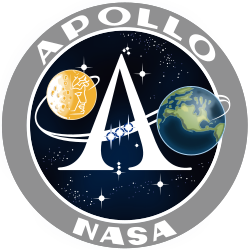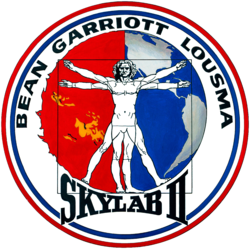Jack R. Lousma
| Jack Lousma | |
|---|---|
 | |
| Land | USA |
| Organisation | NASA |
| ausgewählt | 4. April 1966 (5. NASA-Gruppe) |
| Einsätze | 2 Raumflüge |
| Start des ersten Raumflugs | 28. Juli 1973 |
| Landung des letzten Raumflugs | 30. März 1982 |
| Zeit im Weltraum | 67d 11h 13m |
| EVA-Einsätze | 2 |
| EVA-Gesamtdauer | 11h 02m |
| ausgeschieden | 1. Oktober 1983 |
| Raumflüge | |
Jack Robert Lousma (* 29. Februar 1936 in Grand Rapids, Michigan) ist ein ehemaliger US-amerikanischer Astronaut. Er kommunizierte 1970 als Capsule Communicator bei der Apollo 13-Mission mit deren Crew.
Ausbildung
Lousma erhielt 1959 einen Bachelor in Luftfahrttechnik von der University of Michigan und 1965 einen Master in Luftfahrttechnik von der Naval Postgraduate School. Außerdem erhielt er 1973 einen Ehrendoktor in Raumfahrt von der University of Michigan, 1982 einen Ehrendoktor vom Hope College sowie 1986 einen weiteren Ehrendoktor in Betriebswirtschaft vom Cleary College.
1959 ging Lousma zum US Marine Corps und wurde dort als Aufklärungspilot eingesetzt.
Astronautentätigkeit
Mitarbeit am Boden
Im April 1966 gehörte Lousma zu den 19 Astronauten, die von der NASA ausgewählt wurden. Er war Mitglied der Unterstützungsmannschaften für die Apollo-9-, 10- und 13-Missionen. Außerdem war er Ersatz-Docking-Modul-Pilot für das Apollo-Sojus-Test-Projekt.
Bei der Explosion des Tanks mit Flüssigsauerstoff im Servicemodul des Apollo-13-Raumschiffs war es Lousma, der als „Capcom“ (Capsule Communicator) im Missionskontrollzentrum in Houston die Verbindung zur Besatzung hielt und dabei die Meldung von Pilot Jack Swigert “Okay Houston, we’ve had a problem here.” / „Okay, Houston, wir haben da gerade ein Problem (gehabt).“ entgegennahm. Lousma sagte daraufhin: „Hier ist Houston, könntet ihr das bitte wiederholen?“. Daraufhin meldete sich Kommandant Jim Lovell und wiederholte “Houston, we’ve had a problem.”,[1] worauf Lousma den Empfang der Meldung bestätigte und eine Untersuchung durch die Bodencrew ankündigte.
Skylab 3

Am 28. Juli 1973 startete Lousma als Pilot einer Apollokapsel zusammen mit Kommandant Alan Bean und Wissenschaftspilot Owen Garriott zu der 59-tägigen Mission Skylab 3 (SL-3) auf die US-Raumstation Skylab. Die Mannschaft installierte sechs Ersatzgyroskope zur Lageregelung und einen Sonnenschutz. Neben zahlreichen Experimenten stand auch die Beobachtung der Sonne auf dem Programm des bis dahin längsten bemannten Weltraumfluges. Am 25. September wasserte die Apollo-Kapsel im Pazifik und wurde dort von der New Orleans geborgen.
STS-3

Am 22. März 1982 startete Lousma als Kommandant der Raumfähre Columbia zusammen mit Pilot Gordon Fullerton ins All. Die achttägige Mission war der dritte Testflug des neuen Space Shuttles, bei dem die Überprüfung der thermalen Widerstandsfähigkeit des Orbiters im Vordergrund stand. Nach Tests mit dem Roboterarm des Shuttles und anderen erfolgreich durchgeführten Experimenten landete die Columbia in White Sands (New Mexico). Dies war die erste und einzige Landung eines Space Shuttles in White Sands.
Kandidatur für den Senat
Lousma schied 1983 aus der NASA aus. 1984 kandidierte er als Republikaner in Michigan für den US-Senat. Er erhielt jedoch nur 47 % der Stimmen und verlor damit knapp gegen den Demokraten Carl Levin.
Privates
Jack Lousma und seine Frau Gratia Kay haben vier Kinder.
Siehe auch
Weblinks
- Kurzbiografie von Jack R. Lousma bei spacefacts.de
- NASA-Biografie von Jack R. Lousma (englisch; PDF)
- Biografie von Jack R. Lousma in der Encyclopedia Astronautica (englisch)
Einzelnachweise
- ↑ NASA: Detailed Chronology of Events Surrounding the Apollo 13 Accident, Apollo 13 Funkverkehr-Mitschnitt (schriftlich), abgerufen am 4. Februar 2012 (englisch)
| Personendaten | |
|---|---|
| NAME | Lousma, Jack R. |
| ALTERNATIVNAMEN | Lousma, Jack Robert (vollständiger Name) |
| KURZBESCHREIBUNG | US-amerikanischer Astronaut |
| GEBURTSDATUM | 29. Februar 1936 |
| GEBURTSORT | Grand Rapids, Michigan, Vereinigte Staaten |
Auf dieser Seite verwendete Medien
Commander Jack Lousma wearing the communications kit assembly (ASSY) mini headsets (HDSTs), conducts Bubble Separation Experiment on the middeck. Lousma displays experiment in front of the port side forward middeck lockers (meal tray assemblies secured on lockers).
- Astronaut Jack R. Lousma, STS-3 commander, spins a package of colored liquid in zero-gravity aboard the Earth-orbiting space shuttle Columbia. He was actually creating a centrifuge to conduct a test involving the separation of bubbles from the liquid rehydrated strawberry powder for visible clarity. The gas from liquid experiment is a test devised by scientist-astronaut William E. Thornton. The gun-like device at center of left edge is a water-dispenser which the astronauts use in rehydrating food packets, many of which can be seen in the background of this middeck area of the Columbia. Astronaut C. Gordon Fullerton, pilot, exposed this frame with a 35mm camera.
This is the emblem for the second manned Skylab mission. It will be a mission of up to 56 days. The patch symbolizes the main objectives of the flight. The central figure, adapted from Leonardo da Vinci's Vitruvian Man, illustrates the proportions of the human form and suggests the many studies of man himself to be conducted in the zero-gravity environment of space. This drawing is superimposed on two hemispheres representing the two additional main areas of research - studies of the Sun and the development of techniques for survey of the Earth's resources. The left hemisphere show the Sun as it will be seen in the red light radiated by hydrogen atoms in the solar atmosphere. The right hemisphere is intended to suggest the studies of Earth resources to be conducted on Skylab. Although the patch denotes this mission as Skylab II, it is actually consided to be the Skylab III mission. Image ID: S72-51123
Logo of Sts-3 mission
Astronaut Jack R. Lousma.
A close up view of astronaut Jack R. Lousma, Skylab 3 pilot taking a hot bath in the crew quarters of the Orbital Workshop (OWS) of the Skylab space station cluster in Earth Orbit. This picture was taken with a hand-held 35mm Nikon camera. Astronaut Lousma, Alan Bean and Owen K. Garriott remained within the Skylab space station in orbit for 59 days conducting numerous medical, scientific and technological experiments. In deploying the shower facility the shower curtain is pulled up from the floor and attached to the ceiling. The water comes through a push-button shower head attached to a flexible hose. Water is drawn off by a vacuum system.
This is a recording of the space to ground communication from Apollo 13 following the rupture of the number 2 oxygen tank. The communication occurs between the Mission control center in building 30 at the Manned Spacecraft Center in Houston, Texas (later renamed the Lyndon B. Johnson Space Center) and Apollo 13 approximately 321,860 km from Earth. Note that the file name is not an accurate quote because what both Swigert and Lovell said was, "...Houston, we've had a problem...". transcript starting on page 167






